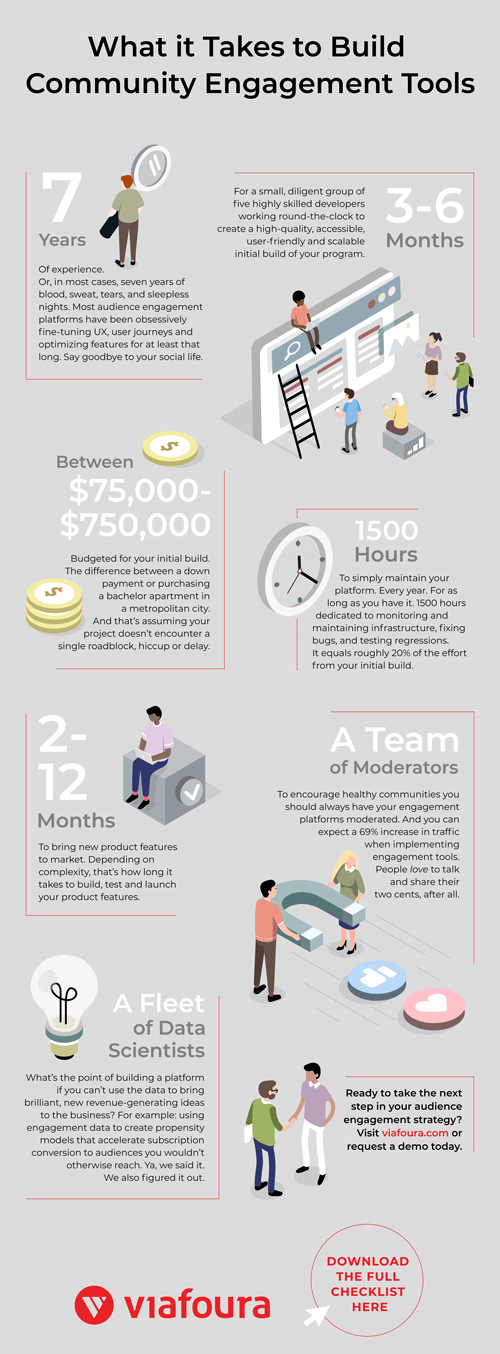Right now, media companies everywhere are racing to stay on top of the ever-evolving trends and technologies in the industry. But with the future constantly barrelling towards us, the most effective path to revenue isn’t always straightforward. As a result, many brands aren’t properly equipped to deal with digital challenges on the road ahead.
No one really knows for sure what the best practices in the media industry will look like in five, 10 or 15 years. What we do know, however, is that you are very capable of putting your best foot forward in setting yourself up for ongoing success.
So would you believe us if we told you that a few simple steps could protect your business?
Well, you’d better buckle up — we’re about to walk you through everything you need to do to futureproof your business. Prepare to gain an edge over your competitors.
1. Invest in New Sources of Revenue
For most media organizations, social media is no longer a reliable source of revenue. While social media proved to be a great source of revenue and digital traffic several years ago, constantly changing algorithms and brand-daming toxicity has since diminished the relationship between media and social platforms.
The best lesson we can take away from the history between media and big tech companies is that media organizations need to stop relying on third-parties to generate revenue from consumers. Instead, it’s important to continuously be testing and analyzing direct ways to earn revenue. Long-term stability will require a direct relationship with your audience, and the more ways you
“There is going to be a new crop of players… that accelerate because they understand how to connect content, commerce, and conversation,” the CEO of Barstool Sports tells the Digital Content Next association. “Companies that do that are going to be in a good spot.”
Sustainable revenue models are now shifting away from ad revenue and towards consumer revenue models, where brands have complete access to their digital community and profits. Gain a competitive edge and set your brand up for success by monetising your audience directly.
2. Optimize Your Platform for Engagement
Whether you’re a news publisher or operate a video-streaming platform, building loyalty among your audience members translates into long-term success. That said, social engagement is a powerful building block of trust and loyalty in a digital community.
So instead of trying (and failing) to grow loyal followers via social media, incorporate engagement tools right into the fabric of your brand’s platform. Intertwine tools like live conversations, real-time blogging, ratings and reviews as well as live chats with your content to get people seriously interested in what you offer.
Add additional layers of interaction to your platform by engaging with your audience directly, through digital Q&As, personalized emails and recommended content lists. By having popular journalists or TV personalities chat with your audience, you can generate excitement in your community and prove that your content is worth the subscription fee.
At the end of the day, you don’t want to be a stranger to your audience. Interacting with them shows that they mean more to you than money. And that, folks, is how to generate long-term trust, no matter what kind of curveball the future may throw at you.
3. Set Up Preventative Moderation Measures
Nevermind the future, the present is already volatile.
There are trolls, bots, spammers and misinformation wreaking havoc throughout the internet. So if you can’t protect your brand in the face of existing threats, how can you possibly be prepared to deal with these growing issues in the future?
In both the present and future, moderation across your user-generated content is a must for any brand hoping to draw in active subscribers and retain them.
For a moment, picture sports fans debating over a penalty during a live stream of a game. A real-time chat, where individuals exchange passionate thoughts, is a perfect opportunity for building community engagement around this event. However, a troll can easily ruin the experience by taunting, mocking and harassing your loyal users. This is why it’s essential to put some kind of moderation in place to protect your community.
Explore the different types of moderation here.
According to a new report by What’s New In Publishing, consumer subscription fatigue is becoming a reality for many publishers and streaming platforms alike. Creating an effective conversion strategy matters now more than ever with so much competition fighting over consumer dollars.
So once you have your paywall and engagement tools in place, it’s time for you to connect all of the moving pieces together. Plant those seeds of engagement to grow your audience. Then ensure your engagement and paywall solutions are working together so that your active, subscription-ready users can be sent a paywall message.
Finding the right strategy for your business may take a bit of trial and error. But testing out different ways to engage, target and monetize your audience members is a surefire way to boost revenue in the long run.
5. Put Your Audience First
In the digital age, your audience is everything. Which is why you should pull every possible piece of information you can about your audience members from your first-party data, and use those insights to your advantage.
Take the time to identify who your most loyal audience members are, and how to best cater to them. For instance, OTT platforms may want to consider personalizing the content-streaming experience, with recommended or related videos.
Your content strategy should be geared towards what subscribers find important and relatable. So: figure out who you’re serving, what content and experience they value, and invest heavily in that.
Condé Nast has also developed a short exercise for publishers that can help your team shift its editorial strategy towards a more audience-oriented approach.
“Anything that distracts a publisher from focusing on their most loyal audiences, is a losing strategy,” reads a report by the Tow Center of Digital Journalism.
Wise words for media organizations everywhere.











